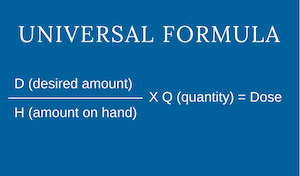Drug Calculations: How to Use the Universal Formula
Medication administration is a core competency for all nurses in every clinical setting. A key skill required to safely dispense drugs is the ability to perform accurate dosage calculations. New technologies such as bar code administration and smart infusion pumps have helped to reduce medication errors, however nurses cannot rely completely on these advances. In this blog series we will review several drug calculation methods. The first technique is the universal formula or the “desired over have” method.
Before we begin, every nurse should be comfortable with basic metric conversions. You can find a handy conversion chart in our Nursing Pocket Card: Common Calculations.
Universal Formula (Toney-Butler, 2021)
In the universal formula (or “desired over have method”), the desired amount (D) is the dose prescribed and the amount on hand (H) or the amount you “have” is the available dose or concentration. The quantity (Q) is the form and amount in which the drug is supplied (i.e. tablet, capsule, liquid). To calculate the dose, take the desired amount and divide it by the amount on hand, then multiply it by the quantity, like this:
Examples
Oral Dose
Cephalexin (Keflex) 750 mg P.O. every 12 hours is ordered. The pharmacy stocks 250 mg tablets. How many tablets should be administered per dose?
Intravenous (IV) Dose
An order for digoxin 0.5 mg IV daily is placed. Digoxin 0.25 mg/mL is available from the pharmacy. How many mL will you need to administer a 0.5 mg dose?
Subcutaneous Dose
Heparin 7500 units subcutaneous every 12 hours is ordered. The pharmacy provides a heparin vial with a concentration of 5000 units/mL. How many mL will you need to administer 7500 units?
General Tips:
- Check that your answer makes sense clinically.
- Triple check your work.
- Have a colleague or pharmacist check your work.
- Know general therapeutic drug doses for commonly administered medications.
References: Koharchik, L.S. & Hardy, E.C. (2013). As easy as 1, 2, 3! Dosage calculations. Nursing Made Incredibly Easy!, 11(1), 25 – 29.
Order Now